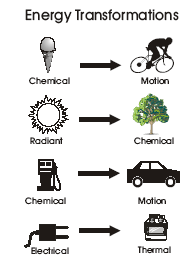All Sources of Energy
We are offering information on Oil, Natural Gas, Coal, Hydrogen, Wind, Solar, Geothermal, Water and Biomass energy source information.
Energy comes in different forms, such as heat . . .
thermal, light . . . radiant, mechanical, electrical,
chemical, and nuclear energy.  Energy is in everything.
We use energy to do everything we do, from making a
jump shot to baking our favorite cookies to sending
astronauts into space -- energy is there, making sure
we have the power to do it all. There are two types
of energy -- stored (potential) energy and working (kinetic)
energy. For example, the food you eat contains chemical
energy, and your body stores this energy until you release
it when you work or play. Learn more about these different
forms of energy.
Energy is in everything.
We use energy to do everything we do, from making a
jump shot to baking our favorite cookies to sending
astronauts into space -- energy is there, making sure
we have the power to do it all. There are two types
of energy -- stored (potential) energy and working (kinetic)
energy. For example, the food you eat contains chemical
energy, and your body stores this energy until you release
it when you work or play. Learn more about these different
forms of energy.
All forms of energy are stored in different ways, in the energy sources that we use every day. These sources are divided into two groups -- renewable (an energy source that can be replenished in a short period of time) and nonrenewable (an energy source that we are using up and cannot recreate in a short period of time). Renewable and nonrenewable energy sources can be used to produce secondary energy sources including electricity and hydrogen.
Renewable energy sources include solar energy, which comes from the sun and can be turned into electricity and heat. Wind, geothermal energy from inside the earth, biomass from plants, and hydropower and ocean energy from water are also renewable energy sources.
However, we get most of our energy from nonrenewable energy sources, which include the fossil fuels -- oil, natural gas, and coal. They're called fossil fuels because they were formed over millions and millions of years by the action of heat from the Earth's core and pressure from rock and soil on the remains (or "fossils") of dead plants and animals. Another nonrenewable energy source is the element uranium, whose atoms we split (through a process called nuclear fission) to create heat and ultimately electricity.
We use all these energy sources to generate the electricity we need for our homes, businesses, schools, and factories. Electricity "energizes" our computers, lights, refrigerators, washing machines, and air conditioners, to name only a few uses.
We use energy to run our cars and trucks. Both the gasoline used in our cars, and the diesel fuel used in our trucks are made from oil. The propane that fuels our outdoor grills and makes hot air balloons soar is made from oil and natural gas.
WHAT IS ENERGY?
Energy makes change; it does things for us. It moves cars along the road and boats over the water. It bakes a cake in the oven and keeps ice frozen in the freezer. It plays our favorite songs on the radio and lights our homes. Energy makes our bodies grow and allows our minds to think. Scientists define energy as the ability to do work. People have learned how to change energy from one form to another so that we can do work more easily and live more comfortably.
FORMS OF ENERGY
Energy is found in different forms, such as light, heat, sound and motion. There are many forms of energy, but they can all be put into two categories: kinetic and potential.
KINETIC ENERGY
Kinetic energy is motion of waves, electrons, atoms, molecules, substances, and objects.
Electrical Energy is the movement of electrical charges. Everything is made of tiny particles called atoms. Atoms are made of even smaller particles called electrons, protons, and neutrons. Applying a force can make some of the electrons move. Electrical charges moving through a wire is called electricity. Lightning is another example of electrical energy.
Radiant Energy is electromagnetic energy that travels in transverse waves. Radiant energy includes visible light, x-rays, gamma rays and radio waves. Light is one type of radiant energy. Solar energy is an example of radiant energy.
Thermal Energy, or heat, is the internal energy in substances––the vibration and movement of the atoms and molecules within substances. Geothermal energy is an example of thermal energy.
Motion Energy is the movement of objects and substances from one place to another. Objects and substances move when a force is applied according to Newton’s Laws of Motion. Wind is an example of motion energy.
Sound is the movement of energy through substances in longitudinal (compression/rarefaction) waves. Sound is produced when a force causes an object or substance to vibrate––the energy is transferred through the substance in a wave.
POTENTIAL ENERGY
![]() Potential Energy is stored energy and the energy of
position or gravitational energy. There are several
forms of potential energy.
Potential Energy is stored energy and the energy of
position or gravitational energy. There are several
forms of potential energy.
![]() Chemical Energy is energy stored in the bonds of atoms
and molecules. It is the energy that holds these particles
together. Biomass, petroleum, natural gas, and propane
are examples of stored chemical energy.
Chemical Energy is energy stored in the bonds of atoms
and molecules. It is the energy that holds these particles
together. Biomass, petroleum, natural gas, and propane
are examples of stored chemical energy.
![]() Stored Mechanical Energy is energy stored in objects
by the application of a force. Compressed springs and
stretched rubber bands are examples of stored mechanical
energy.
Stored Mechanical Energy is energy stored in objects
by the application of a force. Compressed springs and
stretched rubber bands are examples of stored mechanical
energy.
![]() Nuclear Energy is energy stored in the nucleus of an
atom or the energy that holds the nucleus together.
The energy can be released when the nuclei are combined
or split apart. Nuclear power plants split the nuclei
of uranium atoms in a process called fission. The sun
combines the nuclei of hydrogen atoms in a process called
fusion. Scientists are working on creating fusion energy
on earth, so that someday there might be fusion power
plants.
Nuclear Energy is energy stored in the nucleus of an
atom or the energy that holds the nucleus together.
The energy can be released when the nuclei are combined
or split apart. Nuclear power plants split the nuclei
of uranium atoms in a process called fission. The sun
combines the nuclei of hydrogen atoms in a process called
fusion. Scientists are working on creating fusion energy
on earth, so that someday there might be fusion power
plants.
![]() Gravitational Energy is the energy of position or place.
A rock resting at the top of a hill contains gravitational
potential energy. Hydropower, such as water in a reservoir
behind a dam, is an example of gravitational potential
energy.
Gravitational Energy is the energy of position or place.
A rock resting at the top of a hill contains gravitational
potential energy. Hydropower, such as water in a reservoir
behind a dam, is an example of gravitational potential
energy.




